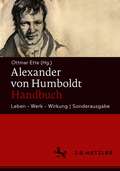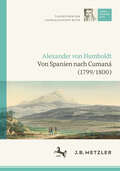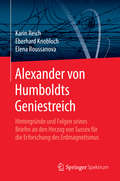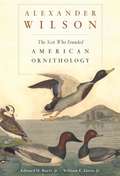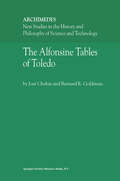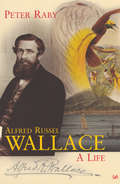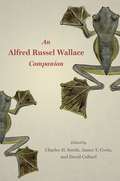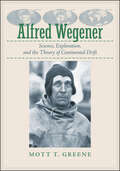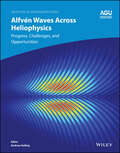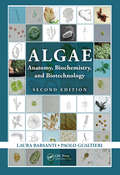- Table View
- List View
Alexander von Humboldt-Handbuch: Leben – Werk – Wirkung | Sonderausgabe
Alexander von Humboldt ist seit dem Ausgang des 20. Jahrhunderts in den unterschiedlichsten Wissensbereichen und Wissenschaftsfeldern zu einer bedeutenden Figur im öffentlichen Diskurs geworden. Das Handbuch macht das gewaltige Oeuvre Humboldts zugänglich und beschreibt Wege und Wirkungen dieses herausragenden Forschers, Gelehrten und Schriftstellers. Ausgehend von der Einsicht in die transdisziplinäre Ausrichtung der Humboldtschen Wissenschaft rekonstruiert es Verbindungen und Wechselwirkungen der unterschiedlichen Betätigungsfelder dieses Vordenkers einer vernetzten Welt. Im Werkteil werden nicht nur die großen Buchpublikationen, sondern auch die unselbständigen Schriften, die umfangreiche Korrespondenz und der Nachlass behandelt. Humboldts wissenschaftliche Aktivitäten werden aus unterschiedlichen Blickwinkeln, von der Wissenschaftsgeschichte und den Naturwissenschaften bis hin zu Geschichts- und Sprachwissenschaft beleuchtet. Auch seine Tätigkeitsfelder in den Bereichen Politik und Diplomatie oder Kunst und Ästhetik werden diskutiert, schließlich die wichtigsten seiner Beziehungen zu Wissenschaftlern und Literaten.
Alexander von Humboldt: Tagebücher der Amerikanischen Reise: Von Spanien nach Cumaná (edition humboldt print #1)
Der erste Tagebuchband der amerikanischen Reise Alexander von Humboldts gibt Einblicke in die Überfahrt von Europa nach Amerika, den Aufenthalt auf Teneriffa und in das Leben und Arbeiten in Cumaná. In seinem Tagebuch beschreibt Humboldt, wie Klima und Vegetation die Kulturgeschichte des Menschen prägen, und bringt seinen Abscheu gegenüber der Sklaverei zum Ausdruck. Sein Interesse gilt ebenso der tropischen Pflanzen- und Tierwelt wie der Lebensweise der indigenen Bevölkerung. Im Herbst 1799 wird er zudem Zeuge einer Sonnenfinsternis, eines Erdbebens und eines beeindruckenden Meteorschauers. Besonders zu faszinieren vermag sein beständiges Ringen um eine Optimierung der Messmethoden. Sein Ziel ist die Kartierung eines noch weitgehend unerschlossenen Kontinents, und er weiß, dass die enormen Anstrengungen, die er und sein Forschungspartner Aimé Bonpland auf sich nehmen, nur dann gerechtfertigt wären, wenn die erhobenen Daten valide sind. – Der durchgängig kommentierte Text ist in neun Kapitel unterteilt, denen jeweils kleine Einführungen vorangestellt sind.
Alexander von Humboldts Geniestreich: Hintergründe und Folgen seines Briefes an den Herzog von Sussex für die Erforschung des Erdmagnetismus
by Karin Reich Eberhard Knobloch Elena RoussanovaDer Brief, den Alexander von Humboldt am 23. April 1836 an Augustus Frederick, den Herzog von Sussex – damals Präsident der Royal Society of London – richtete, ist wahrscheinlich der wichtigste und der folgenreichste Brief, den der berühmte deutsche Forschungsreisende in seinem Leben verfasst hat. Dieser These gehen die Autoren der vorliegenden Studie nach, zumal die Quellen, Hintergründe und Folgen dieses epochemachenden Briefes bislang nicht im Detail untersucht waren.Humboldt ging es vor allem um den Ausbau und die Erweiterung der erdmagnetischen Forschungen im britischen Empire, was die globale Erforschung dieses rätselhaften Naturphänomens fördern sollte. Er hat sein Schreiben genau zum richtigen Zeitpunkt verfasst: Der Brief löste eine Lawine von Forschungsaktivitäten aus. Von Humboldts Initiative profitierte nicht allein Großbritannien, sondern auch Russland, die USA und – was bislang kaum wahrgenommen bzw. herausgestellt wurde – Göttingen, das zum Zentrum der erdmagnetischen Forschungen weltweit avancierte. Die Studie zeigt deutlich, dass Humboldts Brief nur deshalb so überaus erfolgreich sein konnte, weil er sich auf die von Carl Friedrich Gauß und Wilhelm Weber in Göttingen erzielten Forschungen zu stützen vermochte: So war Humboldts Erfolg auch ein Verdienst von Gauß und Weber. Der Brief Humboldts wird in der vorliegenden Monographie erstmals nach der Originalvorlage ediert und auch in deutscher Übersetzung vorgestellt. Ferner werden weitere relevante Dokumente sowohl in Originalsprache als auch in deutscher Übersetzung veröffentlicht. Die Darstellung wird von informativem, historischem Bildmaterial ergänzt. Der Band wendet sich an ein Fach- wie auch an ein wissenschaftshistorisch interessiertes Publikum.
Alexander Wilson: The Scot Who Founded American Ornithology
by Edward H. Burtt Jr.On the bicentennial of his death, this beautifully illustrated volume pays tribute to the Scot who became the father of American ornithology. Alexander Wilson made unique contributions to ecology and animal behavior. His drawings of birds in realistic poses in their natural habitat inspired Audubon, Spencer Fullerton Baird, and other naturalists.
Alexander Wilson: The Scot Who Founded American Ornithology
by Edward H. Burtt Jr.On the bicentennial of his death, this beautifully illustrated volume pays tribute to the Scot who became the father of American ornithology. Alexander Wilson made unique contributions to ecology and animal behavior. His drawings of birds in realistic poses in their natural habitat inspired Audubon, Spencer Fullerton Baird, and other naturalists.
Alexia: Diagnosis, Treatment and Theory
by Alexander Leff Randi StarrfeltThis book is a comprehensive review of the main acquired disorders of reading: hemianopic, pure and central alexia. The authors review the diagnostic criteria for each of the different types of disorder, and the efficacy of the therapeutic studies that have attempted to remediate them. The different theoretical models of adult reading, which largely rest on how the reading system responds to injury, are also discussed and evaluated. Focal brain injury caused by stroke and brain tumors are discussed in depth as are the effects of dementia on reading.This book starts with a chapter on normal reading, followed by chapters on hemianopic alexia, pure alexia and central alexia, each structured in the same way, with: a description of the condition; a historical review of cases to date; psychophysics; consideration of the causative lesions; evidence from functional imaging studies on patients and, most importantly, a review of the evidence base for treating each condition. Finally, there is a chapter on how patient data has informed how we think about reading.Alexia: Diagnosis, Treatment and Theory is aimed at neuropsychologists (both experimental and clinical), neurologists, speech therapists and others who deal with patients whose reading has been affected by an acquired brain injury, as well as interested students studying language disorders.
The Alfalfa Genome (Compendium of Plant Genomes)
by Long-Xi Yu Chittaranjan KoleThis book is the first comprehensive compilation of deliberations on whole genome sequencing of the diploid and tetraploid alfalfa genomes including sequence assembly, gene annotation, and comparative genomics with the model legume genome, functional genomics, and genomics of important agronomic characters. Other chapters describe the genetic diversity and germplasm collections of alfalfa, as well as development of genetic markers and genome-wide association and genomic selection for economical important traits, genome editing, genomics, and breeding targets to address current and future needs. Altogether, the book contains about 300 pages over 16 chapters authored by globally reputed experts on the relevant field in this crop. This book is useful to the students, teachers, and scientists in the academia and relevant private companies interested in genetics, breeding, pathology, physiology, molecular genetics and breeding, biotechnology, and structural and functional genomics. The work is also useful to seed and forage industries.
The Alfonsine Tables of Toledo (Archimedes #8)
by José Chabás B.R. GoldsteinThe Alfonsine Tables of Toledo is for historians working in the fields of astronomy, science, the Middle Ages, Spanish and other Romance languages. It is also of interest to scholars interested in the history of Castile, in Castilian-French relations in the Middle Ages and in the history of patronage. It explores the Castilian canons of the Alfonsine Tables and offers a study of their context, language, astronomical content, and diffusion. The Alfonsine Tables of Toledo is unique in that it: includes an edition of a crucial text in history of science; provides an explanation of astronomy as it was practiced in the Middle Ages; presents abundant material on early scientific language in Castilian; presents new material on the diffusion of Alfonsine astronomy in Europe; describes the role of royal patronage of science in a medieval context.
Alfred Nobel: Idealist zwischen Wissenschaft und Wirtschaft (Lebensgeschichten aus der Wissenschaft)
by Kenne FantAlfred Russel Wallace: A Life
by Peter RabyIn 1858, aged thirty-five, weak with malaria, isolated in the remote Spice Islands, Alfred Russel Wallace wrote to Charles Darwin: he had, he said excitedly, worked out a theory of natural selection. Darwin was aghast - his work of decades was about to be scooped. Within a fortnight, his outline and Wallace's paper were presented jointly in London. A year later, with Wallace still at the opposite side of the world, On the Origin of Species was published. Wallace had none of Darwin's advantages or connections. Born in Usk, Gwent, in 1823, he left school at fourteen and in his mid-twenties spent four years in the Amazon collecting for museums and wealthy patrons, only to lose all his finds in a shipboard fire in mid-Atlantic. He vowed never to travel again. Yet two years later he was off to the East Indies, beginning an eight-year trek over thousands of miles; here he discovered countless unknown species and identified for the first time the point of divide between Asian and Australian fauna, 'Wallace's Line'. With vigour and sensitivity, Peter Raby reveals Wallace as a courageous and unconventional explorer. After his return, he plunged into a variety of controversies, staying vital and alert until his death at the age of 90, in 1913. Gentle, self-effacing, and remarkably free from the racism that blighted so many of his contemporaries, Wallace is one of the neglected giants of the history of science and ideas. This stirring biography - the first for many years - puts him at centre stage, where he belongs.
Alfred Russel Wallace: A Life
by Peter RabyIn 1858, Alfred Russel Wallace, aged thirty-five, weak with malaria, isolated in the Spice Islands, wrote to Charles Darwin: he had, he said excitedly, worked out a theory of natural selection. Darwin was aghast--his work of decades was about to be scooped. Within two weeks, his outline and Wallace's paper were presented jointly in London. A year later, with Wallace still on the opposite side of the globe, Darwin published On the Origin of Species. This new biography of Wallace traces the development of one of the most remarkable scientific travelers, naturalists, and thinkers of the nineteenth century. With vigor and sensitivity, Peter Raby reveals his subject as a courageous, unconventional explorer and a man of exceptional humanity. He draws more extensively on Wallace's correspondence than has any previous biographer and offers a revealing yet balanced account of the relationship between Wallace and Darwin. Wallace lacked Darwin's advantages. A largely self-educated native of Wales, he spent four years in the Amazon in his mid-twenties collecting specimens for museums and wealthy patrons, only to lose his finds in a shipboard fire in the mid-Atlantic. He vowed never to travel again. Yet two years later he was off to the East Indies on a vast eight-year trek; here he discovered countless species and identified the point of divide between Asian and Australian fauna, 'Wallace's Line.' After his return, he plunged into numerous controversies and published regularly until his death at the age of ninety, in 1913. He penned a classic volume on his travels, founded the discipline of biogeography, promoted natural selection, and produced a distinctive account of mind and consciousness in man. Sensitive and self-effacing, he was an ardent socialist--and spiritualist. Wallace is one of the neglected giants of the history of science and ideas. This stirring biography--the first for many years--puts him back at center stage, where he belongs.
Alfred Russel Wallace: Letters from the Malay Archipelago
by John Van Wyhe Kees RookmaakerThis volume brings together the letters of the great Victorian naturalist Alfred Russel Wallace (1823-1913) during his famous travels of 1854-62 in the Malay Archipelago (now Singapore, Malaysia, and Indonesia). it was these travels which led him to come independently to the same conclusion as Charles Darwin: that evolution occurs through natural selection. Beautifully written, the letters are filled with lavish descriptions of the remote regions he explored, the peoples, and fascinating details of the many new species of mammals, birds, and insects he discovered during his time there. John van Wyhe and Kees Rookmaaker present new transcriptions of each of the letters, including recently discovered letters that shed light on the voyage and on questions such as Wallace's reluctance to publish on evolution, and why he famously chose to write to Darwin rather than to send his work to a journal directly. A revised account of Wallace's itinerary based on new research by the editors forms part of an introduction that sets the context of the voyage, and the volume includes full notes to all letters. Together the letters form a remarkable and vivid document of one of the most important journeys of the 19th century by a great Victorian naturalist.
An Alfred Russel Wallace Companion
by Charles Smith James A. Costa David CollardAlthough Alfred Russel Wallace (1823–1913) was one of the most famous scientists in the world at the time of his death at the age of ninety, today he is known to many as a kind of “almost-Darwin,” a secondary figure relegated to the footnotes of Darwin’s prodigious insights. But this diminution could hardly be less justified. Research into the life of this brilliant naturalist and social critic continues to produce new insights into his significance to history and his role in helping to shape modern thought. Wallace declared his eight years of exploration in southeast Asia to be “the central and controlling incident” of his life. As 2019 marks one hundred and fifty years since the publication of The Malay Archipelago, Wallace’s canonical work chronicling his epic voyage, this collaborative book gathers an interdisciplinary array of writers to celebrate Wallace’s remarkable life and diverse scholarly accomplishments. Wallace left school at the age of fourteen and was largely self-taught, a voracious curiosity and appetite for learning sustaining him throughout his long life. After years as a surveyor and builder, in 1848 he left Britain to become a professional natural history collector in the Amazon, where he spent four years. Then, in 1854, he departed for the Malay Archipelago. It was on this voyage that he constructed a theory of natural selection similar to the one Charles Darwin was developing, and the two copublished papers on the subject in 1858, some sixteen months before the release of Darwin’s On the Origin of Species. But as the contributors to the Companion show, this much-discussed parallel evolution in thought was only one epoch in an extraordinary intellectual life. When Wallace returned to Britain in 1862, he commenced a career of writing on a huge range of subjects extending from evolutionary studies and biogeography to spiritualism and socialism. An Alfred Russel Wallace Companion provides something of a necessary reexamination of the full breadth of Wallace’s thought—an attempt to describe not only the history and present state of our understanding of his work, but also its implications for the future.
An Alfred Russel Wallace Companion
by Charles H. Smith David CollardAlthough Alfred Russel Wallace (1823–1913) was one of the most famous scientists in the world at the time of his death at the age of ninety, today he is known to many as a kind of “almost-Darwin,” a secondary figure relegated to the footnotes of Darwin’s prodigious insights. But this diminution could hardly be less justified. Research into the life of this brilliant naturalist and social critic continues to produce new insights into his significance to history and his role in helping to shape modern thought. Wallace declared his eight years of exploration in southeast Asia to be “the central and controlling incident” of his life. As 2019 marks one hundred and fifty years since the publication of The Malay Archipelago, Wallace’s canonical work chronicling his epic voyage, this collaborative book gathers an interdisciplinary array of writers to celebrate Wallace’s remarkable life and diverse scholarly accomplishments. Wallace left school at the age of fourteen and was largely self-taught, a voracious curiosity and appetite for learning sustaining him throughout his long life. After years as a surveyor and builder, in 1848 he left Britain to become a professional natural history collector in the Amazon, where he spent four years. Then, in 1854, he departed for the Malay Archipelago. It was on this voyage that he constructed a theory of natural selection similar to the one Charles Darwin was developing, and the two copublished papers on the subject in 1858, some sixteen months before the release of Darwin’s On the Origin of Species. But as the contributors to the Companion show, this much-discussed parallel evolution in thought was only one epoch in an extraordinary intellectual life. When Wallace returned to Britain in 1862, he commenced a career of writing on a huge range of subjects extending from evolutionary studies and biogeography to spiritualism and socialism. An Alfred Russel Wallace Companion provides something of a necessary reexamination of the full breadth of Wallace’s thought—an attempt to describe not only the history and present state of our understanding of his work, but also its implications for the future.
An Alfred Russel Wallace Companion
by Charles H. Smith David CollardAlthough Alfred Russel Wallace (1823–1913) was one of the most famous scientists in the world at the time of his death at the age of ninety, today he is known to many as a kind of “almost-Darwin,” a secondary figure relegated to the footnotes of Darwin’s prodigious insights. But this diminution could hardly be less justified. Research into the life of this brilliant naturalist and social critic continues to produce new insights into his significance to history and his role in helping to shape modern thought. Wallace declared his eight years of exploration in southeast Asia to be “the central and controlling incident” of his life. As 2019 marks one hundred and fifty years since the publication of The Malay Archipelago, Wallace’s canonical work chronicling his epic voyage, this collaborative book gathers an interdisciplinary array of writers to celebrate Wallace’s remarkable life and diverse scholarly accomplishments. Wallace left school at the age of fourteen and was largely self-taught, a voracious curiosity and appetite for learning sustaining him throughout his long life. After years as a surveyor and builder, in 1848 he left Britain to become a professional natural history collector in the Amazon, where he spent four years. Then, in 1854, he departed for the Malay Archipelago. It was on this voyage that he constructed a theory of natural selection similar to the one Charles Darwin was developing, and the two copublished papers on the subject in 1858, some sixteen months before the release of Darwin’s On the Origin of Species. But as the contributors to the Companion show, this much-discussed parallel evolution in thought was only one epoch in an extraordinary intellectual life. When Wallace returned to Britain in 1862, he commenced a career of writing on a huge range of subjects extending from evolutionary studies and biogeography to spiritualism and socialism. An Alfred Russel Wallace Companion provides something of a necessary reexamination of the full breadth of Wallace’s thought—an attempt to describe not only the history and present state of our understanding of his work, but also its implications for the future.
An Alfred Russel Wallace Companion
Although Alfred Russel Wallace (1823–1913) was one of the most famous scientists in the world at the time of his death at the age of ninety, today he is known to many as a kind of “almost-Darwin,” a secondary figure relegated to the footnotes of Darwin’s prodigious insights. But this diminution could hardly be less justified. Research into the life of this brilliant naturalist and social critic continues to produce new insights into his significance to history and his role in helping to shape modern thought. Wallace declared his eight years of exploration in southeast Asia to be “the central and controlling incident” of his life. As 2019 marks one hundred and fifty years since the publication of The Malay Archipelago, Wallace’s canonical work chronicling his epic voyage, this collaborative book gathers an interdisciplinary array of writers to celebrate Wallace’s remarkable life and diverse scholarly accomplishments. Wallace left school at the age of fourteen and was largely self-taught, a voracious curiosity and appetite for learning sustaining him throughout his long life. After years as a surveyor and builder, in 1848 he left Britain to become a professional natural history collector in the Amazon, where he spent four years. Then, in 1854, he departed for the Malay Archipelago. It was on this voyage that he constructed a theory of natural selection similar to the one Charles Darwin was developing, and the two copublished papers on the subject in 1858, some sixteen months before the release of Darwin’s On the Origin of Species. But as the contributors to the Companion show, this much-discussed parallel evolution in thought was only one epoch in an extraordinary intellectual life. When Wallace returned to Britain in 1862, he commenced a career of writing on a huge range of subjects extending from evolutionary studies and biogeography to spiritualism and socialism. An Alfred Russel Wallace Companion provides something of a necessary reexamination of the full breadth of Wallace’s thought—an attempt to describe not only the history and present state of our understanding of his work, but also its implications for the future.
Alfred Tarski: Philosophy Of Language And Logic (History of Analytic Philosophy)
by Douglas Patterson Michael BeaneyThis study looks to the work of Tarski's mentors Stanislaw Lesniewski and Tadeusz Kotarbinski, and reconsiders all of the major issues in Tarski scholarship in light of the conception of Intuitionistic Formalism developed: semantics, truth, paradox, logical consequence.
Alfred Tarski and the Vienna Circle: Austro-Polish Connections in Logical Empiricism (Vienna Circle Institute Yearbook #6)
by Jan Wolenski Eckehart KöhlerThe larger part of Yearbook 6 of the Institute Vienna Circle constitutes the proceedings of a symposium on Alfred Tarski and his influence on and interchanges with the Vienna Circle, especially those on and with Rudolf Carnap and Kurt Gödel. It is the first time that this topic has been treated on such a scale and in such depth. Attention is mainly paid to the origins, development and subsequent role of Tarski's definition of truth. Some contributions are primarily historical, others analyze logical aspects of the concept of truth. Contributors include Anita and Saul Feferman, Jan Wolenski, Jan Tarski and Hans Sluga. Several Polish logicians contributed: Gzegorczyk, Wójcicki, Murawski and Rojszczak. The volume presents entirely new biographical material on Tarski, both from his Polish period and on his influential career in the United States: at Harvard, in Princeton, at Hunter, and at the University of California at Berkeley. The high point of the analysis involves Tarski's influence on Carnap's evolution from a narrow syntactical view of language, to the ontologically more sophisticated but more controversial semantical view. Another highlight involves the interchange between Tarski and Gödel on the connection between truth and proof and on the nature of metalanguages. The concluding part of Yearbook 6 includes documentation, book reviews and a summary of current activities of the Institute Vienna Circle. Jan Tarski introduces letters written by his father to Gödel; Paolo Parrini reports on the Vienna Circle's influence in Italy; several reviews cover recent books on logical empiricism, on Gödel, on cosmology, on holistic approaches in Germany, and on Mauthner.
Alfred Weber and the Crisis of Culture, 1890-1933 (Palgrave Studies in Cultural and Intellectual History)
by C. LoaderAlfred Weber was an important participant in the dialogue over the political and cultural crises of the late Empire and Weimar Republic. This study connects Weber's career to the social, political, intellectual, cultural, and institutional contexts of the period.
Alfred Wegener: Science, Exploration, and the Theory of Continental Drift
by Mott T. GreeneAlfred Wegener aimed to create a revolution in science which would rank with those of Nicolaus Copernicus and Charles Darwin. After completing his doctoral studies in astronomy at the University of Berlin, Wegener found himself drawn not to observatory science but to rugged fieldwork, which allowed him to cross into a variety of disciplines. The author of the theory of continental drift;¢;‚¬;€?the direct ancestor of the modern theory of plate tectonics and one of the key scientific concepts of the past century;¢;‚¬;€?Wegener also made major contributions to geology, geophysics, astronomy, geodesy, atmospheric physics, meteorology, and glaciology. Remarkably, he completed this pathbreaking work while grappling variously with financial difficulty, war, economic depression, scientific isolation, illness, and injury. He ultimately died of overexertion on a journey to probe the Greenland icecap and calculate its rate of drift. This landmark biography;¢;‚¬;€?the only complete account of the scientist;€™s fascinating life and work;¢;‚¬;€?is the culmination of more than twenty years of intensive research. In Alfred Wegener, Mott T. Greene places Wegener;€™s upbringing and theoretical advances in earth science in the context of his brilliantly eclectic career, bringing Wegener to life by analyzing his published scientific work, delving into all of his surviving letters and journals, and tracing both his passionate commitment to science and his thrilling experiences as a polar explorer, a military officer during World War I, and a world-record;€“setting balloonist. In the course of writing this book, Greene traveled to every place that Alfred Wegener lived and worked;¢;‚¬;€?to Berlin, rural Brandenburg, Marburg, Hamburg, and Heidelberg in Germany; to Innsbruck and Graz in Austria; and onto the Greenland icecap. He also pored over archives in Copenhagen, Munich, Marburg, Graz, and Bremerhaven, where the majority of Wegener;€™s surviving papers are found. Written with great immediacy and descriptive power, Alfred Wegener is a powerful portrait of the scientist who pioneered the modern concept of unified Earth science. The book should be of interest not only to earth scientists, students of polar travel and exploration, and historians but to all readers who are fascinated by the great minds of science.
Alfred Wegener: Polarforscher und Entdecker der Kontinentaldrift (Lebensgeschichten aus der Wissenschaft)
by Christine Reinke-KunzeAlfvén Waves Across Heliophysics: Progress, Challenges, and Opportunities (Geophysical Monograph Series)
by Andreas KeilingAlfvén Waves Across Heliophysics Progress, Challenges, and Opportunities Alfvén waves are fundamental to the dynamics of space plasmas. Recent advances in our knowledge about Alfvén waves have come from several directions, including new space missions to unexplored heliospheric regions, sophisticated rocket campaigns in the auroral zone, enlarged magnetometer arrays and radar networks, and significant advances in computer modeling. Alfvén Waves Across Heliophysics: Progress, Challenges, and Opportunities is an interdisciplinary collaboration from different space science communities to review recent and current Alfvén wave research. Volume highlights include: Alfvén waves in the solar atmosphereAlfvén waves at the giant planetsAlfvén waves at MarsAlfvén waves in moon-magnetosphere systemsAlfvén waves in geospaceAlfvén waves in the laboratory The American Geophysical Union promotes discovery in Earth and space science for the benefit of humanity. Its publications disseminate scientific knowledge and provide resources for researchers, students, and professionals.
Alfvén Waves Across Heliophysics: Progress, Challenges, and Opportunities (Geophysical Monograph Series)
by Andreas KeilingAlfvén Waves Across Heliophysics Progress, Challenges, and Opportunities Alfvén waves are fundamental to the dynamics of space plasmas. Recent advances in our knowledge about Alfvén waves have come from several directions, including new space missions to unexplored heliospheric regions, sophisticated rocket campaigns in the auroral zone, enlarged magnetometer arrays and radar networks, and significant advances in computer modeling. Alfvén Waves Across Heliophysics: Progress, Challenges, and Opportunities is an interdisciplinary collaboration from different space science communities to review recent and current Alfvén wave research. Volume highlights include: Alfvén waves in the solar atmosphereAlfvén waves at the giant planetsAlfvén waves at MarsAlfvén waves in moon-magnetosphere systemsAlfvén waves in geospaceAlfvén waves in the laboratory The American Geophysical Union promotes discovery in Earth and space science for the benefit of humanity. Its publications disseminate scientific knowledge and provide resources for researchers, students, and professionals.
Algae: Anatomy, Biochemistry, and Biotechnology, Second Edition
by Laura Barsanti Paolo GualtieriA single-source reference on the biology of algae, Algae: Anatomy, Biochemistry, and Biotechnology, Second Edition examines the most important taxa and structures for freshwater, marine, and terrestrial forms of algae. Its comprehensive coverage goes from algae's historical role through its taxonomy and ecology to its natural product possibilities.
